The world witnessed Donald Trump making his “8th” peace deal in the Middle East, where he urged leaders to set aside “old feuds” with a US-brokered ceasefire between Israel and Hamas, discussing the future of the largely destroyed Gaza Strip.
Against this contemporary backdrop, one can’t help but imagine history’s most unusual peace deals applied to Gaza — with Trump in the middle, of course.
From the medieval Treaty of the Cow, where a single cow had ended a border dispute, to the Vienna Convention, which had codified diplomacy into an intricate art, each historical model offers a quirky lens through which to view the high-stakes negotiations in Gaza.
Treaty of the Cow (1274, France & Flanders)
Settle a border dispute by literally giving a cow as compensation — because why not?
This medieval masterpiece of diplomacy ended a border spat by quite literally handing over a cow as compensation. No bloodshed, no drawn-out talks — just a cow, a handshake, and probably some very confused witnesses. It was simplicity at its most bovine.
If Gaza had been negotiated under this, Trump would’ve proudly presented a “Peace Cow” as the ultimate symbol of unity. Israel would’ve received new security assurances, Palestine would’ve gained sovereignty, and both sides would’ve shared custody of a Holstein named Peace Moo II. Trump would’ve called it “the most beautiful peace cow — people cried, strong tears.”

Vienna Convention (1961)
The Vienna Convention on Diplomatic Relations set the global rulebook for diplomacy — defining everything from immunity to protocol. It turned the art of negotiation into a structured profession: ambassadors got immunity, embassies got protection, and host nations got headaches when things went wrong. Basically, it made sure everyone played nice — or at least, pretended to.
If Gaza had been negotiated under the Vienna Convention, Trump would’ve transformed it into a glittering diplomatic circus. He’d have demanded the summit be held at “Trump Vienna — best hotel, fantastic chandeliers,” where he’d personally approve the seating chart. Ambassadors would’ve enjoyed immunity but not from Trump’s nicknames (“Sleepy Envoy,” “Boring Delegate”). The final document would’ve been titled “The Very Official, Totally Binding Gaza Peace Thing,” complete with gold trim. When asked about enforcement, Trump would’ve winked and said, “Trust me — diplomacy’s never been this luxurious.”
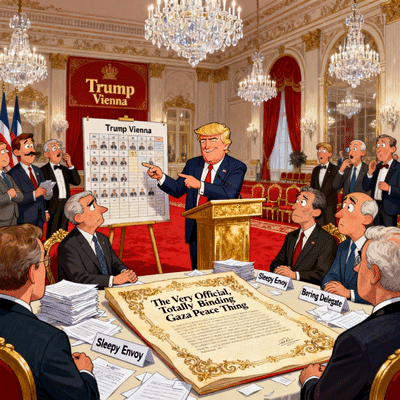
Peace of God / Truce of God (10th–11th c, Europe)
In an early attempt at moral enforcement, the medieval Church declared certain days violence-free — no wars on Sundays, holy days, or during Lent. It was less about strategy and more about divine scheduling.
Under this framework, Gaza peace talks would’ve turned into a “Weekend Truce Deal,” with Trump announcing no fighting from Friday through Sunday because “the ratings dip on holy days.” Religious leaders would’ve nodded approvingly, while aides scrambled to keep him from declaring Monday a “national peace hangover day.”

Treaty of Tordesillas (1494)
Spain and Portugal solved their colonial rivalry by drawing a line across the globe — literally. The Pope approved, indigenous peoples were not consulted, and the mapmakers got a lifetime of bragging rights.
In a Gaza context, Trump would’ve whipped out a Sharpie and drawn “a perfect line, a TREMENDOUS line” straight down the map of the region. “This side, that side — totally fair,” he’d have declared, ignoring protests from actual residents. The resulting border would’ve become a meme within minutes.
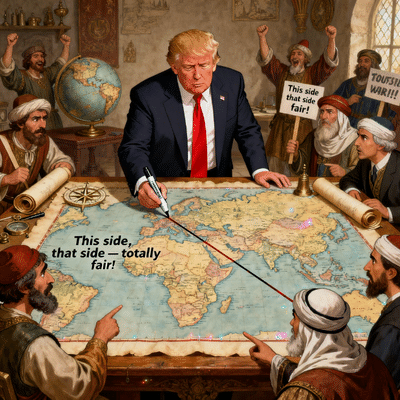
Treaty of the Three Black Eagles (1732)
This shadowy agreement saw Russia, Austria, and Prussia secretly collude to control Poland’s fate — diplomacy done behind velvet curtains and heavy drapes. It was less peace, more plotting.
Applied to Gaza, Trump, Putin , and Erdogan would’ve held a discreet meeting at Mar-a-Lago over shrimp cocktails, claiming to “help both sides win.” The deal’s details would’ve leaked via Truth Social, complete with Trump posting, “Best secret treaty ever — everyone’s jealous!”
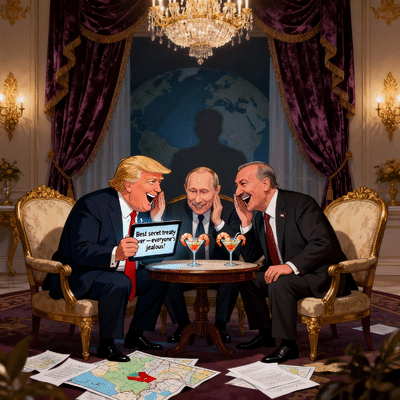
Treaty of the Pyrenees (1659)
This treaty ended decades of war between France and Spain with a grand display of royal marriages, pageantry, and pomp. Diplomacy became theater, complete with brides and border realignments.
In Gaza, the peace talks would’ve unfolded like a wedding special hosted by Trump himself. Symbolic unions between delegations, falafel banquets, and photo ops galore. He would’ve billed it as “The Bachelor: Middle East Edition,” with Jared Kushner officiating and everyone awkwardly applauding.
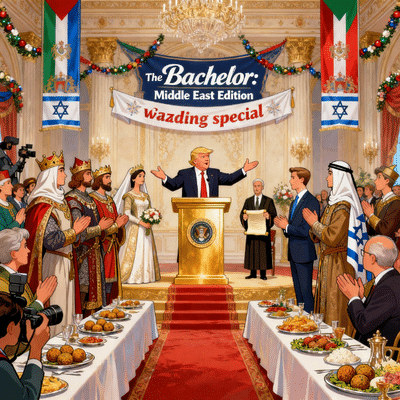
Treaty of Breda (1667)
A prime example of colonial horse-trading, this treaty saw the Dutch and English casually swap territories — New Amsterdam for Suriname. Real estate diplomacy at its peak.
If Gaza had been handled this way, Trump would’ve called it “the biggest land swap deal in history.” Gaza might’ve traded a strip of coastline for resort rights and “beachfront development opportunities.” Both sides would’ve walked away unsure who benefited, but Trump would’ve called it “a huge win for everyone — especially the hotels.”

The 'Peace of the Duck' (Medieval Italy)
Legend has it two warring Italian armies declared peace because they were too hungry to continue. A shared meal — and possibly a duck dinner — ended the conflict. Hunger, it seems, was the great unifier.
In Gaza, this treaty style would’ve led to a “Lunch Truce.” Trump would’ve declared, “Nobody fights on an empty stomach — everybody knows that.” Negotiators would’ve shared roasted duck, and Trump would’ve posed with it, calling it “the ultimate bird of peace.”

Cadaver Synod Truce (897, Rome)
One of history’s darkest absurdities: a pope’s corpse was dug up and put on trial to settle a power dispute. Nothing says “closure” like exhumed litigation.
If Gaza peace had been struck under this model, Trump would’ve insisted on hosting talks beside wax statues of past leaders, “for historical perspective.” At one point, he’d have asked a mannequin for its opinion, declaring later that “the dead have spoken — and they love the deal.”

Peace of Augsburg (1555, Germany)
This treaty divided Europe’s territories by religion, allowing rulers to choose their region’s faith — essentially “cuius regio, eius religio.” It was peace through zoning, faith-style.
If Gaza had followed this model, Trump would’ve introduced “Faith Zoning Reform.” Each neighborhood could pick its religion “like a homeowners’ association,” he’d have explained proudly. Bureaucrats would’ve loved the orderliness; theologians would’ve fled the room.
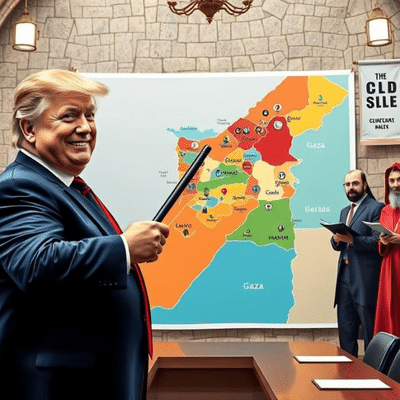
(The article uses AI-generated images for representative purposes.)
Against this contemporary backdrop, one can’t help but imagine history’s most unusual peace deals applied to Gaza — with Trump in the middle, of course.
From the medieval Treaty of the Cow, where a single cow had ended a border dispute, to the Vienna Convention, which had codified diplomacy into an intricate art, each historical model offers a quirky lens through which to view the high-stakes negotiations in Gaza.
Treaty of the Cow (1274, France & Flanders)
Settle a border dispute by literally giving a cow as compensation — because why not?
This medieval masterpiece of diplomacy ended a border spat by quite literally handing over a cow as compensation. No bloodshed, no drawn-out talks — just a cow, a handshake, and probably some very confused witnesses. It was simplicity at its most bovine.
If Gaza had been negotiated under this, Trump would’ve proudly presented a “Peace Cow” as the ultimate symbol of unity. Israel would’ve received new security assurances, Palestine would’ve gained sovereignty, and both sides would’ve shared custody of a Holstein named Peace Moo II. Trump would’ve called it “the most beautiful peace cow — people cried, strong tears.”
Vienna Convention (1961)
The Vienna Convention on Diplomatic Relations set the global rulebook for diplomacy — defining everything from immunity to protocol. It turned the art of negotiation into a structured profession: ambassadors got immunity, embassies got protection, and host nations got headaches when things went wrong. Basically, it made sure everyone played nice — or at least, pretended to.
If Gaza had been negotiated under the Vienna Convention, Trump would’ve transformed it into a glittering diplomatic circus. He’d have demanded the summit be held at “Trump Vienna — best hotel, fantastic chandeliers,” where he’d personally approve the seating chart. Ambassadors would’ve enjoyed immunity but not from Trump’s nicknames (“Sleepy Envoy,” “Boring Delegate”). The final document would’ve been titled “The Very Official, Totally Binding Gaza Peace Thing,” complete with gold trim. When asked about enforcement, Trump would’ve winked and said, “Trust me — diplomacy’s never been this luxurious.”
Peace of God / Truce of God (10th–11th c, Europe)
In an early attempt at moral enforcement, the medieval Church declared certain days violence-free — no wars on Sundays, holy days, or during Lent. It was less about strategy and more about divine scheduling.
Under this framework, Gaza peace talks would’ve turned into a “Weekend Truce Deal,” with Trump announcing no fighting from Friday through Sunday because “the ratings dip on holy days.” Religious leaders would’ve nodded approvingly, while aides scrambled to keep him from declaring Monday a “national peace hangover day.”

Treaty of Tordesillas (1494)
Spain and Portugal solved their colonial rivalry by drawing a line across the globe — literally. The Pope approved, indigenous peoples were not consulted, and the mapmakers got a lifetime of bragging rights.
In a Gaza context, Trump would’ve whipped out a Sharpie and drawn “a perfect line, a TREMENDOUS line” straight down the map of the region. “This side, that side — totally fair,” he’d have declared, ignoring protests from actual residents. The resulting border would’ve become a meme within minutes.
Treaty of the Three Black Eagles (1732)
This shadowy agreement saw Russia, Austria, and Prussia secretly collude to control Poland’s fate — diplomacy done behind velvet curtains and heavy drapes. It was less peace, more plotting.
Applied to Gaza, Trump, Putin , and Erdogan would’ve held a discreet meeting at Mar-a-Lago over shrimp cocktails, claiming to “help both sides win.” The deal’s details would’ve leaked via Truth Social, complete with Trump posting, “Best secret treaty ever — everyone’s jealous!”
Treaty of the Pyrenees (1659)
This treaty ended decades of war between France and Spain with a grand display of royal marriages, pageantry, and pomp. Diplomacy became theater, complete with brides and border realignments.
In Gaza, the peace talks would’ve unfolded like a wedding special hosted by Trump himself. Symbolic unions between delegations, falafel banquets, and photo ops galore. He would’ve billed it as “The Bachelor: Middle East Edition,” with Jared Kushner officiating and everyone awkwardly applauding.
Treaty of Breda (1667)
A prime example of colonial horse-trading, this treaty saw the Dutch and English casually swap territories — New Amsterdam for Suriname. Real estate diplomacy at its peak.
If Gaza had been handled this way, Trump would’ve called it “the biggest land swap deal in history.” Gaza might’ve traded a strip of coastline for resort rights and “beachfront development opportunities.” Both sides would’ve walked away unsure who benefited, but Trump would’ve called it “a huge win for everyone — especially the hotels.”

The 'Peace of the Duck' (Medieval Italy)
Legend has it two warring Italian armies declared peace because they were too hungry to continue. A shared meal — and possibly a duck dinner — ended the conflict. Hunger, it seems, was the great unifier.
In Gaza, this treaty style would’ve led to a “Lunch Truce.” Trump would’ve declared, “Nobody fights on an empty stomach — everybody knows that.” Negotiators would’ve shared roasted duck, and Trump would’ve posed with it, calling it “the ultimate bird of peace.”
Cadaver Synod Truce (897, Rome)
One of history’s darkest absurdities: a pope’s corpse was dug up and put on trial to settle a power dispute. Nothing says “closure” like exhumed litigation.
If Gaza peace had been struck under this model, Trump would’ve insisted on hosting talks beside wax statues of past leaders, “for historical perspective.” At one point, he’d have asked a mannequin for its opinion, declaring later that “the dead have spoken — and they love the deal.”
Peace of Augsburg (1555, Germany)
This treaty divided Europe’s territories by religion, allowing rulers to choose their region’s faith — essentially “cuius regio, eius religio.” It was peace through zoning, faith-style.
If Gaza had followed this model, Trump would’ve introduced “Faith Zoning Reform.” Each neighborhood could pick its religion “like a homeowners’ association,” he’d have explained proudly. Bureaucrats would’ve loved the orderliness; theologians would’ve fled the room.
(The article uses AI-generated images for representative purposes.)
You may also like

Banished Celebrity Traitors star 'revealed' as star points out huge mistake

Now, public sector companies allowed to buy cars of up to 2,500 cc for staff

Women''s WC: Sri Lanka, New Zealand split points after rain washes out match

UK city breaks silence on spending £71k on free bus passes for asylum seekers

IPL adds it up, and still ends up short of valuation crease






